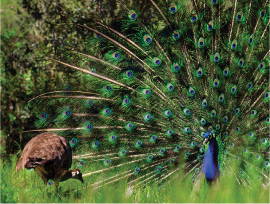 Chapter 11 Self Quiz: Evolution and behavior
Chapter 11 Self Quiz: Evolution and behavior 
 Chapter 11 Self Quiz: Evolution and behavior
Chapter 11 Self Quiz: Evolution and behavior 
 A monkey acquires fear of snakes by observing other monkeys; this is an example of
A monkey acquires fear of snakes by observing other monkeys; this is an example of
 A spider lets her spiderlings eat her alive. This is an example of ________ behavior.
A spider lets her spiderlings eat her alive. This is an example of ________ behavior.
 The male black widow spider achieves mate guarding by
The male black widow spider achieves mate guarding by
 Bright plumage of male peacocks are an example of
Bright plumage of male peacocks are an example of
| Home | © Copyleft Peter Chen 2.0 |